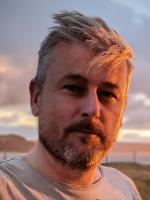
Career
- 2014-date Principal Investigator on Cambridge STFC High Energy Physics theory consolidated grant
- 2011-date Professor of Theoretical Physics, DAMTP, University of Cambridge
- 2025-date Professorial Fellow, Clare Hall
- 2022-2023 Scientific Associate, CERN (on sabbatical leave from Cambridge)
- 2009-2010 Reader, DAMTP, University of Cambridge
- 2004-2008 Lecturer, DAMTP, University of Cambridge
- 2004-2009 PPARC Advanced Fellow, University of Cambridge
- 2002-2004 Postdoctoral researcher, Laboratoire d'Annecy de Physique des Particules Theorie
- 2000-2002 Fellow, TH Division, CERN
- 1998-2000 Postdoctoral researcher, Department of Applied Mathematics and Theoretical Physics, University of Cambridge
- 1995-1998 Higher Scientific Officer, Rutherford Appleton Laboratory
Research
Ben is a member of the Department of Applied Mathematics and Theoretical Physics High Energy Physics research group and The Cambridge Pheno Working Group based at the Cavendish Laboratory. He is a particle phenomenologist and is primarily interested in interpreting data coming from the CERN experiments in terms of new particles and forces. Then he tries to rule such new particles and forces out with other data. If this doesn't work, he asks what theoretical framework do they come from and can this explain unanswered mysteries.
Lecturing
Part III (Master's course), lecture notes and accompanying youtube lectures:
Ph.D. Students
- Eetu Loisa: 2021-2025
- Hannah Banks: 2019-2023
- Maeve Madigan: 2018-2021
- Tom Cridge: 2014-2018
- Sophie Renner: 2012-2016
- Matt Dolan: 2007-2010
- Jordan Skittrall: 2006-2009
- Steve Kom: 2005-2008
Music: Professor Jammin
Selected External Activities
- 2019-date Author of The Review of Particle Physics
- 2018 Quantum Selves art exhibition, Burgh House and Hampstead Museum, London
- 2017 Consultant for Guerilla Science's Intergalactic Travel Bureau stage show
- 2013 TEDx talk, Budapest, Hungary
- 2012 Co-hosted CERN dinner at TEDGlobal event, Edinburgh
- 2005-2006 Scientific Secretary, CERN Council Strategy Group
Publications
Higher order corrections and unification in the minimal supersymmetric standard model: SOFTSUSY3.5
– Computer Physics Communications
(2015)
189,
192
(doi: 10.1016/j.cpc.2014.12.006)
Explaining a CMS eejj excess with R-parity violating supersymmetry and implications for neutrinoless double beta decay
– Physical Review D Particles Fields Gravitation and Cosmology
(2015)
91,
011702
(doi: 10.1103/physrevd.91.011702)
Multiple solutions in supersymmetry and the Higgs.
– Philosophical Transactions of the Royal Society A: Mathematical, Physical and Engineering Sciences
(2015)
373,
1
(doi: 10.1098/rsta.2014.0035)
Resonant slepton production yields CMS eejj and e p Tjj excesses
– Physical Review D
(2015)
91,
015011
(doi: 10.1103/physrevd.91.015011)
Higher order corrections and unification in the minimal supersymmetric standard model: SOFTSUSY3.5.
– Computer Physics Communications
(2014)
189,
192
(doi: 10.1016/j.cpc.2014.12.006)
Investigating multiple solutions in the constrained minimal supersymmetric standard model
– Journal of High Energy Physics
(2014)
2014,
31
(doi: 10.1007/jhep02(2014)031)
Large Hadron Collider constraints on a light baryon-number violating sbottom coupling to a top and a light quark
– The European Physical Journal C
(2014)
74,
1
Next-to-minimal SOFTSUSY.
– Computer Physics Communications
(2014)
185,
2322
(doi: 10.1016/j.cpc.2014.04.015)
Large Hadron Collider constraints on a light baryon-number violating sbottom coupling to a top and a light quark
– European Physical Journal C
(2014)
74,
1
- <
- 8 of 24

